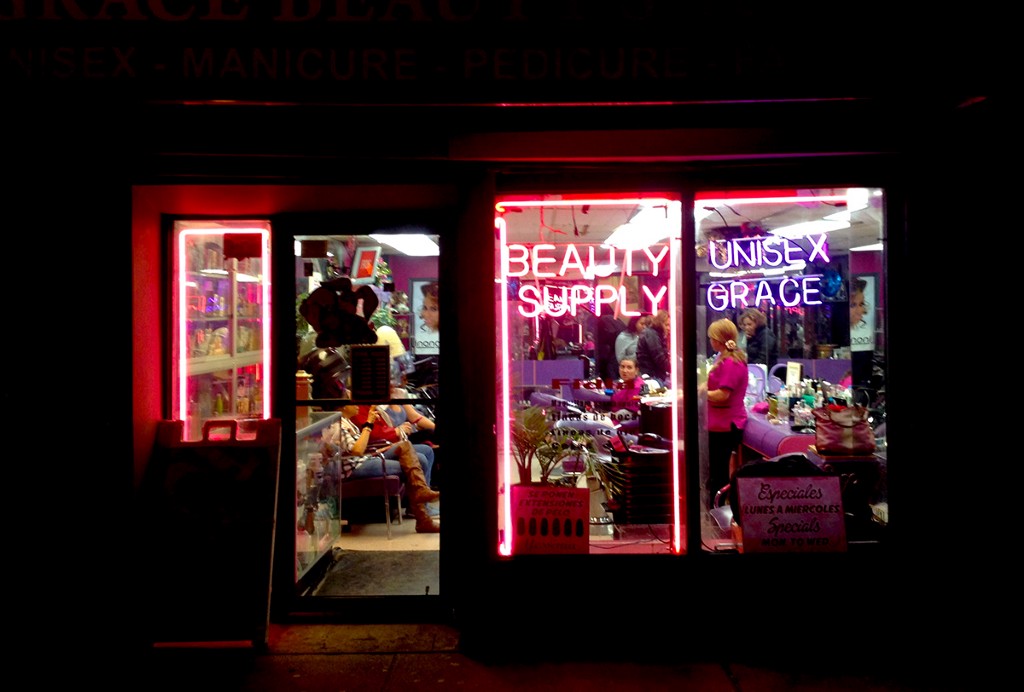Republic of Hair
by Jordi Gassó

At the end of the workday on a brisk March afternoon, as the miasma of hairspray billowed under fluorescent lamps, Jardin Beauty Salon began to fill with women in smart slacks. Freya Fernández, a thirty-three-year-old administrative assistant, had traveled to the Washington Heights salon from Pelham Bay, like she does every two weeks, to have her hair fixed. After a wash and a deep conditioning, a stylist started to set Fernández’s locks. Some of her natural hair dangled under the rollers. The ringlets, still wet, resembled stretched-out coils, a cascade of thin filaments. Josefina González, a jaunty Dominican hairdresser working on another customer, couldn’t help but call out, “Y ese pajoncito? Eso e’ malo! Eso e’ kinky!” (“What’s with that frizzy mess? That is bad! That is kinky.”)
The salon rattled with cackles. “Don’t you worry, she’ll come out of here with straight hair!“ Eunice Mata, another stylist, said. “After a proper blowout, all hair is good hair.”
Mata, who is from Moca, a small city in northern Dominican Republic known more for its coffee harvests than its beauticians, was juggling two customers. She cradled the hair dryer between her neck and shoulder so she could bundle her client’s hair into thick sheaves. “Dominicans imbue hair with pizzazz,” Mata told me as she pulled on the raven curls of a college student. “We know how to deal with all kinds of hair. We’re complete hairdressers. We cut, we dry, we color, we straighten, we lengthen. No one else can do what we do.”
Jardin (“garden” in Spanish), sits in the beating heart of the Dominican diaspora, on the corner of 173rd Street and a stretch of St. Nicholas Avenue known as Juan Pablo Duarte Boulevard, named in honor of the Dominican Republic’s founding father. The salon offers only a few telltale cues that it is a Dominican beauty shop: broken Spanglish, the rhythm and cadence of gossip, telenovelas on the flatscreen, bachata on the radio, women peddling contraband Victoria’s Secret bras, and a girl wearing a tubi, her hair wrapped around her head and secured with bobby pins.
Customers show up to unwind, sip coffee among compatriots, tell Juana how Beatriz lied on her census form, and eventually procure a Dominican-style blowout, once heralded by Fashionista as “one of NYC’s best-kept beauty secrets.” The process, which costs about twenty-five dollars, is intense but straightforward: A stylist sets the client’s damp hair with rollers, then blasts it under a hood dryer for upwards of thirty minutes. Next, the rollers are removed, and the hair is tenaciously smoothed out with a round brush, hand dryer, and a nimble wrist. The result is hair that looks tamed, yet alive with luster.
Though popular, the blowout is not foolproof: Straightening, whether it involves relaxers, blowouts or hot combs, requires a willingness to endure discomfort and accept the risk of painful mishaps, even under the most professional conditions. Overexposure to high heat can burn hair and cripple its strands. Fernández fell victim to scorched ends at a Dominican salon in the Bronx and had to chop off the damaged hair. But if everything goes as planned, a Dominican blowout will yield a straight and winsome hairstyle. Muertecito, Mata dubs it. Pelo lacio, lank as lank can be.
One of Mata’s clients came to Jardin with her children, who were fidgeting on a couch munching Doritos. I felt for the kid slurping from his juice box trying to make the wait less tedious; not long ago, I found myself killing time in the beauty shops of Santo Domingo. After school, my mother, occasionally with one of my two older sisters, used to drag me to her weekly sessions, where I saw how their hair, despite being naturally straight, got tossed and turned like keratin salad until it looked bouncy, ready-made for a photo shoot. At the time, the commandments of hair care struck me as draconian, an odd choreography involving hair yanking and deafening howls of hot air. But for the women in my life, a visit to the hair salon was a cardinal necessity, an inviolable ritual, which usually meant achieving, or retaining, some semblance of sleek, smooth, straight hair.
Pelo bueno, good hair, is straight hair. Bad hair, or pelo malo, is natural textured hair, the scourge with which you’re born. Proponents of the so-called natural hair movement, in turn, seek to dismantle this distinction by redefining entrenched beauty archetypes, encouraging women to work with what they have, and not with what they wish they had. Their dictums of self-care can sound like foghorns in the Aqua Net mist, but they tend to fall on deaf ears. In the Dominican Republic, where the mixed-race demographic constitutes almost three-quarters of the population, droves of salon clients opt for the Europeanized look — the straight look — like a collective reflex. Dominican expatriates cross the Atlantic with these values in tow, to open up shop in Washington Heights, in the Bronx, in Connecticut. With every blowout, the gospel of pelo bueno turns into something tangible.


During the late nineteen-nineties and early aughts in the Dominican Republic, the commercial for a new brand of hair relaxer, Katiuska, became a local pop-culture sensation. The ad borrowed its catchy riff from Wilfrido Vargas’s popular eighties merengue song, “El Africano” (“The African”), which opens with, “Mami, el negro está rabioso”(“Mommy, the black man is rabid” or “acting furiously.”) The Katiuska jingle replaced “negro”:
Mami, mi pelo está rabioso Mommy, my hair is acting furiously
Quiere pelear conmigo It wants to fight me
Ve comprame Katiuska Go buy me some Katiuska
This adversarial tone, depicting a woman in constant quarrel with her uncouth tresses, has since mellowed out in favor of a more pragmatic approach to taming one’s hair. Dominican salon customers, when prompted, often employ the simple answer, that sporting straight hair is a matter of convenience — that when it comes to hair styling, a woman should adhere to a sort of casual realpolitik. And as seasoned practitioners of their craft, Dominican hairdressers perpetuate this standard of beauty by catering to what their audience wants. Culture dictates the guidelines, and it’s more sensible — and financially savvier — to follow them. “It’s not just us,” González told me. “Everyone wants it straight.” She smirked at me. “If you pay me, I’ll wet my hair so I can show you what’s really bad.”
I can spot the Dominican beauty salon nearest to where I live thanks to the tricolor flag hanging in its front window, even if it weren’t named Dominican Beauty Salon. A modest shop nestled between a Burger King and a tattoo parlor in downtown New Haven, Connecticut, with the exception of a single poster, its walls are primarily lined with stock images of white women flaunting coiffed hairdos. I got to know Damaris Comprés, one of four hairdressers on staff. A spitfire from Santo Domingo with a cheekiness only a veteran could get away with, Comprés has lived in the United States for a third of her life: six years in the Bronx sharpening her skills and ten in New Haven, where “there’s less work and more pay,” she says.
Comprés walked me through the intricacies of hair parlance, a vernacular that can be as insidious and generalized as it is imaginative. There’s the usual baseline — the binary of bueno and malo. More specific types of hair lie in between either end of this spectrum. There’s “medium” hair, which can be wavy but not unmanageable; macho, “like the Mexicans,” jet-black hair that’s both straight and dense; and pimiento, or peppercorn, hair that’s tightly curled up into little pellets, which Comprés leaned in and tried to clarify in an emphatic whisper: “kinky hair!”
Hair is the most transparent of racial signifiers, Comprés told me, more revelatory than a family tree. “The Spanish colonizers got way too mixed up,” she said. “But hair doesn’t lie. We all have a bit of black behind the ears. So you can never be too racist. In Santo Domingo, we are all racists. The black man — el prieto — wants nothing to do with another black man.” She placed her tawny left forearm next to mine, pale as ashes. “Look at your skin!” she said. “You’re truly white. I’m high yellow. Actually, no, I have no color.”
That idiom, “we all have a bit of black behind the ears,” carries baggage. In a book that takes its title from this saying, sociologist Ginetta E.B. Candelario writes, “for much of Dominican history, the national body has been defined as not-black, even as black ancestry has been grudgingly acknowledged.” Instead, she says, Dominicans have perceived themselves as “racially Indian and culturally Hispanic,” the descendants of indigenous people.
Hair, in all its malleable glory, helps Dominicans pick a spot on the color wheel, from canela, cinnamon-brown skin, to trigueña, light like wheat. It’s no different than the way any other human beings have harnessed hair throughout civilization — as expression, as ornament, as proof of membership. This is why salons exist: women tender their money, time and self-image, like votive offerings, to a cultural ideal. “It is not a ridiculous investment,” Candelario told me. “It is actually a very rational thing to do, because the expectation comes from outside.”
If Melphine Evans, a black British Petroleum executive, had flattened her braids by getting a fabulous Dominican blowout, would she have avoided termination, as she alleges, for wearing her natural hair? Would my sister’s evolving career as a lawyer in Santo Domingo suffer if she had pelo malo, and not pelo bueno? Straightening your hair is an act of survival as much as it is a gesture of identity, equal parts censuring and affirming.
In December, Miss Rizos (Miss Curls), a salon in the colonial quarters of Santo Domingo, opened its doors to an intrigued public. They provide services for customers who wish to style and maintain their natural hair without resorting to straightening. It started as a lifestyle blog in 2011 when its founder, Carolina Contreras, who was born in the Dominican Republic, visited her native country after an eighteen-year absence. She grew up in Somerville, Massachusetts, but has lived in Santo Domingo for the past four years. “I wanted to give some love to my poor hair, which had been violated so many times by the burning and tugging from all the straightening, blowouts, dryers, hot combs, tongs and irons,” Caroline writes, in Spanish, on her website. “I began to wonder, why was my hair deemed ‘bad,’ ‘hard to manage,’ and why did stylists have to kill my curls? What did my hair do to deserve its ‘bad’ reputation?” The project hints at the potential for a natural hair movement in the motherland. Perhaps one day, its teachings and hair care treatments will migrate to Dominican hubs abroad, through the minds and hands of hairdressers looking for a new life at places like Jardin, or Grace’s Beauty Salon just a few blocks south.
Late one evening last month, I entered Grace’s, where I received the kind of once-over reserved for health inspectors and traveling salesmen. Mary Díaz, a retiree from Santo Domingo, sat on the styling chair closest to the door. She had a satisfied look on her face, finally able to savor a full Dominican-style blowout after surviving breast cancer. Her feet were bare; her shoes lay strewn on the floor among the hair clippings. Her hair appeared thick and plentiful, straightened and silky. She complimented my hair, lifeless, thinning, and flicked at my gossamer bangs.
“Look at you,” she said, without a trace of irony. “Dios te lo bendiga.” God bless your hair. Straightness is still a gift.
